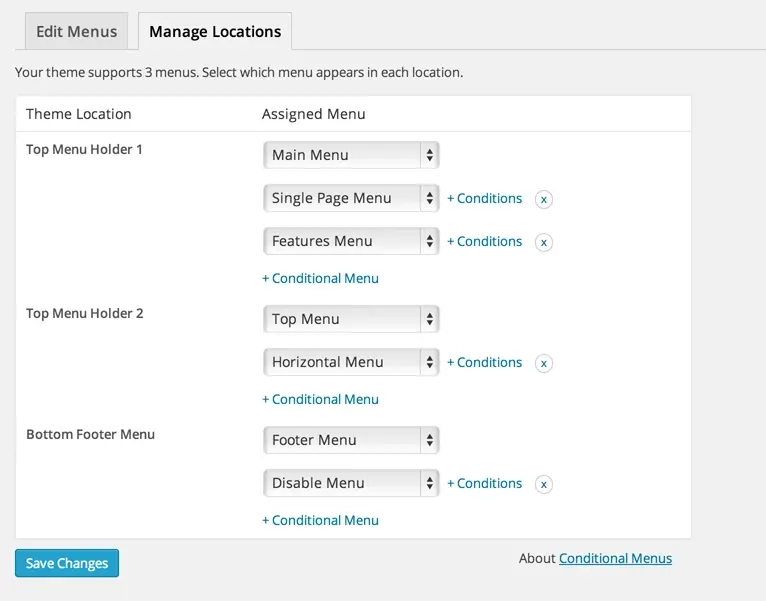Ever need to provide your visitors with a navigational menu based on user role, or the page that they are on? If so, you might need to consider conditional menus. In this article, you’ll learn about how to add WordPress conditional menus in order to give your website visitors a more dynamic experience.
What is a WordPress Conditional Menu?
In WordPress, a conditional menu refers to a menu that displays different items or variations based on specific conditions. It's a dynamic approach to navigation, allowing you to tailor the user experience by showing relevant menu options to different segments of your audience. Unlike static menus, which remain consistent across all pages and users, conditional menus adapt to various factors, creating a more personalized and efficient navigation structure.
Here's a breakdown of what a conditional menu entails and how it functions:
The fundamental idea behind conditional menus is to control menu visibility based on predefined rules. These rules can be triggered by a wide range of criteria, including:
User Roles: Display different menu items to logged-in users, administrators, subscribers, or other custom user roles. For example, an e-commerce site might show "My Account" and "Order History" links only to logged-in customers.
Page Type: Show specific menu items on particular page types, such as the homepage, blog posts, category archives, or custom post types. This allows you to create contextually relevant navigation for different sections of your website.
Taxonomies: Display menu items based on categories or tags. For example, a website with multiple product categories could show category-specific links in the menu.
User Login Status: Show different menus to logged-in versus logged-out users. This is common for membership sites or e-commerce platforms where logged-in users require access to account-specific features.
Device Type: Tailor the menu for mobile devices, tablets, or desktops. This is crucial for responsive design and ensuring optimal navigation on different screen sizes.
Specific Pages or Posts: Show or hide menu items on individual pages or posts. This provides granular control over menu visibility.
Custom Conditions: Developers can create custom conditions using PHP code to trigger menu changes based on virtually any criteria.
Ways to Add WordPress Conditional Menus
Conditional menus can be implemented in WordPress through several methods:
- Plugins
- Theme Functions
- Custom Code
- Menu shortcodes
Plugins
Numerous plugins are available that simplify the process of creating conditional menus. These plugins often provide user-friendly interfaces for setting up rules and conditions without requiring coding knowledge. Examples of plugins that provide conditional logic to menus include Menu Items Visibility Control, and If Menu. These plugins often provide easy to use interfaces to set the conditions.
Theme Functions
Some WordPress themesinclude built-in functionality for conditional menus. Check your theme's documentation to see if this feature is supported.
Custom Code
For advanced users, conditional menus can be created using PHP code within the theme's functions.php file or a custom plugin. This approach offers the greatest flexibility and control but requires coding expertise. WordPress's conditional tags can be utilized within this method.
Menu shortcodes
Some plugins or themes allow the menu to be called via shortcode. The shortcode can then be embedded into a page or post, and the page or post can have conditional logic applied to it.
Benefits of Conditional Menus
If you’re still considering if conditional menus are needed for your website, here’s the benefits of adding them:
Improved User Experience: Conditional menus provide a more relevant and personalized navigation experience, making it easier for users to find the information they need.
Enhanced Website Organization: By showing or hiding menu items based on context, you can create a cleaner and more organized navigation structure.
Increased Conversion Rates: Displaying targeted menu items can guide users towards specific actions, such as making a purchase or signing up for a newsletter.
Reduced Clutter: By hiding irrelevant menu items, you can reduce clutter and simplify the navigation experience.
Targeted Marketing: Conditional menus can be used to promote specific products or services to targeted user segments.
Overall, conditional menus are a powerful tool for creating dynamic and personalized navigation experiences in WordPress. They allow you to adapt your website's menu structure to meet the specific needs of your audience, resulting in a more engaging and effective website.
How to Add WordPress Conditional Menus
Alright, let's create a step-by-step tutorial on how to add conditional menus in WordPress using the "Conditional Menus" plugin.
- Install and Activate the Plugin
- Create Your Menus
- Configure Conditional Logic
- Test Your Conditional Menus
Step 1: Install and Activate the Plugin
- Log in to your WordPress Dashboard: Access your WordPress admin area by entering your username and password.
- Navigate to Plugins: In the left-hand menu, click on "Plugins" and then "Add New."
- Search for "Conditional Menus": In the search bar, type "Conditional Menus."
- Install the Plugin: Locate the "Conditional Menus" plugin (by Themify) in the search results and click "Install Now."
- Activate the Plugin: Once the plugin is installed, click "Activate."
Step 2: Create Your Menus
- Go to Appearance > Menus: In the left-hand menu, navigate to "Appearance" and then "Menus."
- Create Your Menus: If you haven't already, create the menus you want to display conditionally. For example, you might create a "Logged-in Menu," a "Logged-out Menu," and a "Default Menu."
- Add Menu Items: Add the desired pages, posts, custom links, or categories to each menu.
- Save Your Menus: Click the "Save Menu" button for each menu you create.
Step 3: Configure Conditional Logic

- Access Conditional Menus Settings: After installing and activating the plugin, when you are in the menu editor, you will see a "Conditional Menus" tab.
- Select a Menu Location: At the top of the "Conditional Menus" tab, choose the menu location you want to apply conditional logic to.
- Add a Condition: Click the "Add Condition" button.
Choose a Condition Type: A dropdown menu will appear with various condition types, such as
- User Logged In: Display the menu only to logged-in users.
- User Logged Out: Display the menu only to logged-out users.
- User Role: Display the menu to specific user roles (example - Administrator, Editor, Subscriber).
- Page Type: Display the menu on specific page types (example - Homepage, Posts, Archives). e. Specific Pages/Posts: Display the menu on selected pages or posts. f.Taxonomy: Display the menu on specific category or tag pages.
Set Condition Parameters: Depending on the condition type you choose, you'll need to set specific parameters. For example:
- For "User Role," select the desired user roles.
- For "Page Type," select the desired page types.
- For "Specific Pages/Posts" select the pages or posts.
Select the Menu to Display: In the "Menu" dropdown, choose the menu you want to display when the condition is met.
- Add Multiple Conditions (Optional): You can add multiple conditions by clicking the "Add Condition" button again. The plugin allows for AND/OR logic between conditions.
- Set a Default Menu (Optional): Under the conditional rules, there is a section called "Default Menu." Select a menu to be shown when none of the conditions are met. This is very important.
- Save Changes: Click the "Save Changes" button.
Step 4: Test Your Conditional Menus
Log Out and Log In: If you've set conditions based on user login status or roles, log out of your WordPress account and log back in as different users to test the menu visibility.
Visit Different Pages: If you've set conditions based on page types or specific pages, visit those pages to ensure the correct menus are displayed.
Check on Different Devices: If your theme has responsive design, test the menu on different screen sizes to ensure it works correctly.
As a note, when testing, if you use a cache plugin, make sure to clear your website's cache.
Example Scenario For Adding a WordPress Conditional Menu
Let's say you want to:
- Show a "Logged-in Menu" to logged-in users.
- Show a "Logged-out Menu" to logged-out users.
- Show a "Default Menu" to everyone else.
- Create three menus: "Logged-in Menu," "Logged-out Menu," and "Default Menu."
- In the "Conditional Menus" tab, for your menu location, add two conditions:
- Condition 1: "User Logged In," Menu: "Logged-in Menu."
- Condition 2: "User Logged Out," Menu: "Logged-out Menu."
- Set the "Default Menu" to "Default Menu."
- Save your changes.
In Summary
By following the steps in this article on how to add WordPress conditional menus, you can effectively use the "Conditional Menus" plugin to create dynamic and personalized navigation experiences on your WordPress website. Your website visitors will appreciate how you made their ability to navigate your site easier.
Frequently Asked Questions
Is WordPress free?
All you need to do to use WordPress is to invest in a web hosting plan since the software itself is free.
Is BuddyPress WordPress free?
BuddyPress is free to use as a WordPress plugin. However, you might incur costs for additional themes, plugins, or hosting services depending on your website's needs.
Are WordPress plugins free?
WordPress has loads of plugins you can install, some of them are free, but some of them you will need to pay for. You can learn how to use WordPress Plugins on our blog.
Why choose hosting for WordPress?
WordPress is so popular because it allows people to create websites with total customization. With hundreds of apps available for one-click installations, creating something that’s eye-catching and unique is much easier with a CMS like WordPress .

Nile Flores is a long time professional blogger, as well as WordPress website designer and developer from the St. Louis Metro East. Nile blogs at NileFlores.com, where she’s passionate about helping website owners, whether they’re small business owners or bloggers. She teaches about Blogging, Social Media, Search Engine Optimization, Website Design, and WordPress. Additionally, Nile loves to speak at WordCamps (WordPress conferences) across the United States. When Nile isn’t knee-deep in coding, she’s a proud mom of a college student, and enjoys oil painting, cigar smoking, nail art design, and practicing traditional Okinawan kempo karate.
View all posts by Nile Flores





















